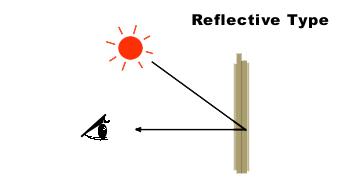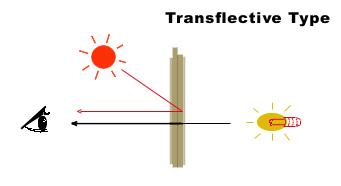LCD Display Mode
Each LCD has two polarizers, the front and rear polarizers, applied accordingly across the front of the display viewing surface and across the rear of the display to determine how the infuse light into the display. The front polarizer is always transmissive and not selectable by the user, however the rear polarizer has three choices and two grades for each choice.
Reflective Polarizer
Reflective displays have an opaque rear polarizer that includes a diffuse reflector, such as brushed aluminum. This layer reflects polarized ambient light that has entered the front of the display back trough the LCD cell. Reflective displays require ambient light to be seen. They exhibit high brightness, excellent contrast, and wide viewing angles. They are particularly suitable for use in battery operated equipment where an adequate level of light is always available. Reflective LCD's cannot be backlit, however they can be front lighted in some applications.

Transmissive Polarizer
Transmissive displays have a clear polarizer on the front and the back. The display therefore depends on light coming through from the back of the display toward the observer in order to be seen. Most, but not all transmissive displays are negative image, and we sometimes add colored filters to different areas of the display to highlight different annunciators. Another example of a transmissive polarizer display would be a transparent window where you could see the segments superimposed over your line of vision through the display window (this assumes a sufficient ambient light source exists on either side of the window).

Transflective Polarizer
Transflective displays have a rear polarizer which includes a translucent material which reflects part of the ambient light, and also transmits backlighting. As the name implies, it is a compromise between the transmissive and reflective viewing mode. Used in reflection, it is not as bright and has lower contrast than the reflective type LCD, but it can be backlit for use in low light conditions. This polarizer is the best selection for a display that can be used in all lighting conditions with a backlight.

Commercial Grade Polarizer
The grade of a polarizer determines its operational and storage temperature range. The commercial grade polarizer operates typically between -10°C to +60°C.
Industrial Grade Polarizer
The grade of a polarizer determines its operational and storage temperature range. The industrial grade polarizer operates typically between -30°C to +80°C. Other temperature ranges are also available.
- Pre:LCD Viewing Direction (Bias An 2018/11/20
- Next:Positive and Negative Display 2018/11/20
